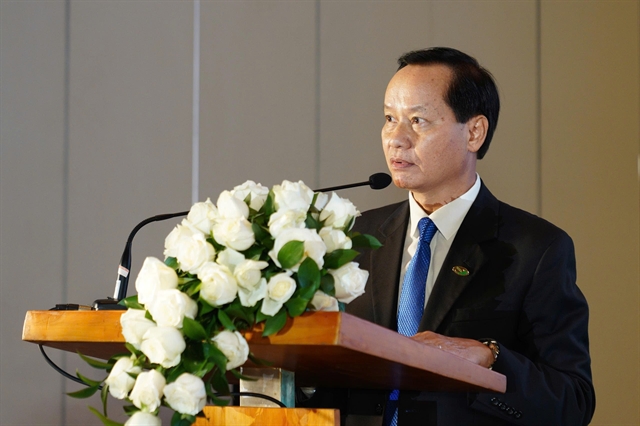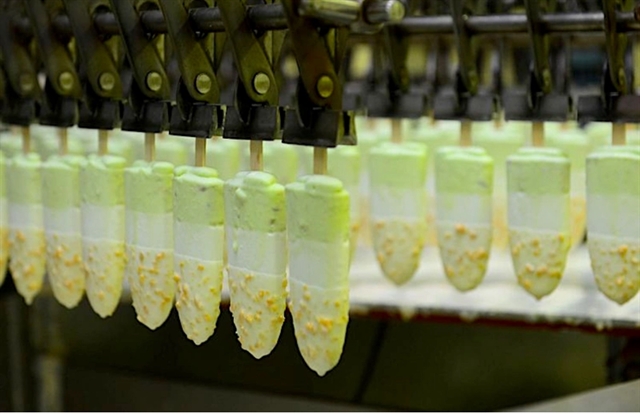 Economy
Economy

The Việt Nam Asset Management Company has decided to hike its reference interest rate on bad debts to 9.9 per cent from the fourth quarter, up from 9.7 per cent.
 |
The Việt Nam Asset Management Company has decided to hike its reference interest rate on bad debts to 9.9 per cent from the fourth quarter, up from 9.7 per cent. — Photo vietstock.vn |
Compiled by Thiên Lý
The Việt Nam Asset Management Company has decided to hike its reference interest rate on bad debts to 9.9 per cent from the fourth quarter, up from 9.7 per cent.
The rate is calculated based on the average deposit interest rates at the four State-owned joint stock banks, Agribank, BIDV, VietinBank, and Vietcombank.
The reference rate determines the pay-offs in a financial contract.
The average interest rate of the banking sector’s four biggest players has shown signs of increasing in recent times.
Vietinbank has the highest deposit interest rates and shows clear signs of hiking the rates.
Since the beginning of this year its deposits interest rates have risen by 0.2-0.5 percentage points to 4.8-6 per cent.
Other banks too have begun to hike deposit interest rates starting late last month.
VPBank, for instance, increased its rates by 0.2 percentage points for six- to 11-month terms to 6.3-6.5 per cent. Techcombank’s rates for deposits of four to six months are up 0.2-0.3 percentage points to 5.3-5.7 per cent.
Normally, banks hike interest rates in the last few months of the year when demand for credit often increases ahead of the peak shopping season, and has a knock-on effect on deposit rates.
But the hikes were not expected to happen this year because the State Bank of Việt Nam had made great efforts to keep them steady by keeping its interest rates lower and improving banks’ liquidity.
But its efforts are seemingly in vain.
The central bank recently announced several policies following the Government’s demand to cut interest rates.
In July it cut several key benchmark rates such as refinance rates, discount rates, the rate on overnight loans, and lending rates for priority sectors.
It also bought foreign exchange to improve its reserves, which helped improve banks’ đồng liquidity.
The central bank’s moves have partly contributed to reducing the interest rates on the bond and inter-bank markets.
But they did not affect the deposit interest rates.
Analysts have expressed concern that the hikes in deposit interest rates will make it difficult to achieve the Government’s plan to further cut lending interest rates by 0.5 per cent to support enterprises.
Many analysts attributed the hikes in deposit interest rates to the rising inflation rate and credit demand.
They said individuals often decide to deposit in banks based on the inflation rate.
In the first seven months of the year prices were quite steady, sometimes even declining. But in recent months they have been trending upward, rising to 3.9 per cent, almost reaching the full-year inflation target of 4 per cent.
In August the prices of 10 out of 11 groups of commodities increased compared to July. Drugs and health services registered the highest increase of 2.86 per cent. Transport was up by 2.13 per cent, food and catering services by 1.06 per cent, housing and construction materials by 0.93 per cent, and education by 0.57 per cent.
The General Statistics Office has predicted that fuel prices will continue to rise until year-end, affecting the prices of several essential goods.
In its recently updated ”Asia prospect” report, the ADB adjusted its forecast for Việt Nam’s average inflation rates to 4.5 per cent this year and 5 per cent next year.
The Government’s recent loosening of credit policy to hike the credit growth target to over 20 per cent from the earlier 18 per cent is another important reason for the increase in inflation.
The increase in the deposit interest rates also is due to the pressure from the foreign exchange market.
The demand for foreign exchange, particularly from import firms, often increases at the year-end ahead of the peak shopping and festival seasons.
This pushes up the value of the greenback against the đồng.
To hold on to their deposits, banks then have to hike interest rates on đồng deposits.
The Industrial Urban Development Joint Stock Company No.2 (D2D) has seen its share price go up by 57 per cent from VNĐ36,300 (US$2) at the beginning of the year to VNĐ56,900 ($3)on October 4 on the HCM City Securities Market (HOSE).
D2D is engaged in development of real estate and infrastructure projects at the Nhơn Trạch Industrial Park No.2 in Dong Nai Province.
Another share to surge was the Nam Tân Tuyên Industrial Park Joint Stock Company based in Bình Dương Province: Its price more than doubled in the period from VNĐ35,000 to VNĐ73,200.
The Vĩnh Phúc Infrastructure Development Joint Stock Company rose from VNĐ45,000 in early August to VNĐ65,000 just a month later.
Market observers said shares of companies involved in industrial parks have appreciated sharply in the last nine months, with many of them reporting big profits.
The Kinh Bắc Joint Stock Company, the owner of eight industrial parks, including Tân Phú Trung, Quế Võ, Quang Châu and Tràng Duệ, achieved after-tax profit of VNĐ420 billion ($18.5 million) in the first haft of 2016, a year-on-year increase of 67 per cent.
The Long Hậu Joint Stock Company, the owner of the Long Hậu Industrial Park, reported profits of VNĐ39 billion ($1.72 million) in the first six months on 2016, up 56 per cent.
The Tín Nghĩa Industrial park Joint Stock Company’s profits rose 50 per cent to VNĐ33.5 billion in the first half of this year.
Analysts said the sharp rise in foreign direct investment (FDI) this year has been an important factor in pushing up the prices of IP developers’ shares.
According to the Ministry of Planning and Investment, in the first nine months of the year new FDI coming into Việt Nam was worth US$25.48 billion, up 34.3 per cent over the same period last year, of which $12.5 billion has been disbursed, up 13.4 per cent.
Importantly, of the amount, US$183.5 billion went into processing and manufacturing businesses, which are mainly situated in industrial parks.
For instance, many new FDI enterprises like Luxshare ICT and JA Solar have become tenants of Kinh Bắc Company’s industrial parks this year.
The industrial park operators’ policy of steady dividends is also considered a strength. — VNS




